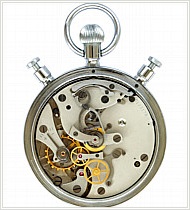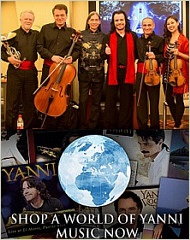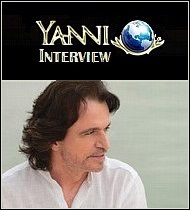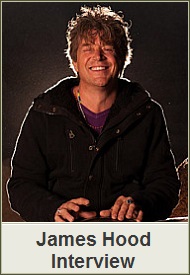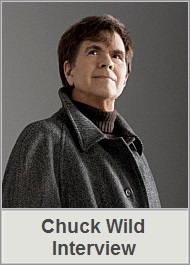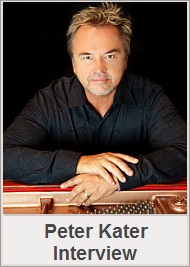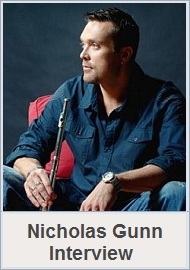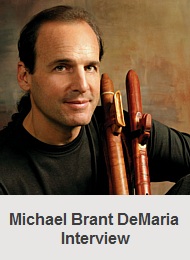Posts Tagged ‘Coburn Tuller’

Coburn Tuller from Springfield Missouri is a New Age artist releasing an innovative new album that is capturing the attention of many review publicists, and the buying public upon its initial release. One reason for the increasing interest given to his debut album is undeniably the relaxing qualities of his music. Another reason could be related to the unique melodic intonations heard on his first album which were produced from a musical instrument he invented and has named The Tones.
 Coburn Tuller’s first album release is entitled Butterfly Tones. It is a rare occasion when an artist can discover a completely new and original sound identity for themselves, but this is the given circumstance with Coburn Tuller.
Coburn Tuller’s first album release is entitled Butterfly Tones. It is a rare occasion when an artist can discover a completely new and original sound identity for themselves, but this is the given circumstance with Coburn Tuller.
The exclusive Butterfly Tones release which features 9 songs of melodic bell timbres has proven to be an innovative source of musical harmony, and one of the most original arrangements available in recent memory.
New Age Music World host John Olsen recently had the opportunity to meet Coburn Tuller in person for their interview which covers topics about Coburn’s first release and his one of a kind instrument. Included are accolades of praise made by some of the industry’s top New Age review publicists. Music World is pleased to present this interview to Coburn Tuller’s fans and to our site visitors.
Interview with Coburn Tuller;
John Olsen: It was truly a pleasure to meet you and your family for the first time Coburn. My wife and I also had a great time meeting some of your friends and the impromptu concert you performed for everyone on the unique instrument you invented and have aptly named The Tones.
Coburn Tuller: Glad you enjoyed it. It’s always a pleasure to have good friends over and playing the Tones is always fun.
John: Would you like to begin by telling everyone the circumstances of how your idea for The Tones first began?
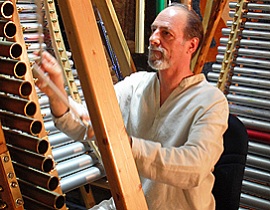 Coburn Tuller: It was during one of my midnight walks when I heard the sound of wind chimes wafting through the evening air. I’d heard the tinkle-tinkle kind of chimes before, but these were the new generation of beautiful sounding wind chimes that had just come out. That was in October of 1996. The nest day I was passing my favorite metal store and just cruised in to see what they might have in the left over bin. Among the chunks of aluminum was a round tube that when struck with a mallet sounded for almost 2 minutes. I was mesmerized. So I went back to get some more and soon had 7, then 14 and then 20 Tones to play and experiment with. Thus began 12 years of various designs and many detours until the present set emerged.
Coburn Tuller: It was during one of my midnight walks when I heard the sound of wind chimes wafting through the evening air. I’d heard the tinkle-tinkle kind of chimes before, but these were the new generation of beautiful sounding wind chimes that had just come out. That was in October of 1996. The nest day I was passing my favorite metal store and just cruised in to see what they might have in the left over bin. Among the chunks of aluminum was a round tube that when struck with a mallet sounded for almost 2 minutes. I was mesmerized. So I went back to get some more and soon had 7, then 14 and then 20 Tones to play and experiment with. Thus began 12 years of various designs and many detours until the present set emerged.
John: Our interview together includes pictures of your instrument, but to give everyone a better idea of what is involved, could you describe the materials and dimension of The Tones?
Coburn Tuller: The present set was completed in 2008. It consists of 90 tones of aluminum and brass ranging from 7 in. to over 6 ft. in length. The three wooden pyramid frames are slightly over 8 feet high and the entire set is 7 feet deep x 9 feet across. All together is weighs almost 750 pounds.
John: You were telling me that over the past 15 years you have devoted a lot of time perfecting your instrument which must have been a real challenge at times. What were some of the early prototypes like, and could you describe some of the challenges involved with fabricating a new musical instrument?
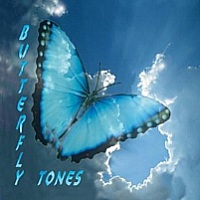 Coburn Tuller: There were a variety of early designs. At first I simply suspended each Tones in cradles of fishing line at each node. After a few months I rigged a set of 25 Tones into a frame with two layers, one on top of the other like a marimba or two layer amadinda. I tried simply bolting the Tones in place but found that they had almost no ring at all, so I went back to the string idea experimenting with various types of cord and eventually went back to heavy duty fishing line for this model. I played this design all through the first winter and following spring until I had more time to experiment.
Coburn Tuller: There were a variety of early designs. At first I simply suspended each Tones in cradles of fishing line at each node. After a few months I rigged a set of 25 Tones into a frame with two layers, one on top of the other like a marimba or two layer amadinda. I tried simply bolting the Tones in place but found that they had almost no ring at all, so I went back to the string idea experimenting with various types of cord and eventually went back to heavy duty fishing line for this model. I played this design all through the first winter and following spring until I had more time to experiment.
I next tried other kinds of metal, copper, aluminum conduit and stainless steel-whatever I could find at the salvage yard. The stainless sounded more like hitting a pipe but the other two had promise. Mind you, I had to work my normal business as a set builder so there were weeks and even months when we had a big set to build that I had absolutely no time whatsoever for Tones.
I suppose the biggest prototype was the five layer instrument I began around 2000. It was to have 2 layers of aluminum thick wall, one of aluminum conduit, one of copper and a fifth of brass if I could find it at the scrap yard, which was where a good portion of the metal came from. I did get the first two layers built including the damper system designed to allow the Tones to be muted by degrees depending on how hard you pressed on the pedals. But I suspended the project when it failed to ring like I knew it could if only I could build it correctly. You see, the main impetus has always been the sound and even when other people would complement me on the sound it made, I always knew there was another dimension of sound in there somewhere.
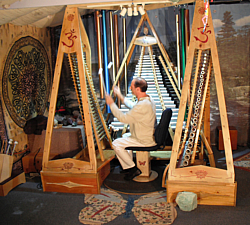 About this time I noticed that I was playing one note more than any other. At first I thought I just liked the G tone best, but eventually I noticed that particular note had vibrato as well as sustain. This caused me to rework the entire set and replace every note with one that had vibrato. Quite the chore since only one in 5 or 6 Tones has that quality.
About this time I noticed that I was playing one note more than any other. At first I thought I just liked the G tone best, but eventually I noticed that particular note had vibrato as well as sustain. This caused me to rework the entire set and replace every note with one that had vibrato. Quite the chore since only one in 5 or 6 Tones has that quality.
In 2002 we started a yoga studio and I built a set of 7 Tones that hung vertically from a simple sweeping Zen type frame. We used it for om meditations before and after yoga practice. It was a little tricky since the Tones would swing and clang together if you were not real careful how you struck them. One day, one of the strings broke and the Tones crashed to the floor. In frustration I asked my then sweetheart Ellen, “What should I do now?” She leaned over and peered at the wreckage and said,”What if you hang them horizontal.” Brilliant! Then I saw that they could have a pyramid shaped frame and I was off and running in the direction that led to the present set. It took another 2 years to build the first pyramid set and an additional 3 more years for the other two pyramids, but the sought after design was finally coming together.
The biggest challenge all along has been that there is nothing else like it so I had no one else’s experience to go on. I just had to keep at it until either I stumbled upon the right course or, as so often happens, someone else suggested something that turned out to lead to the best way to do it.
John: Was tuning each aluminum tube to a true pitch one of the most challenging aspects, and could you tell us the tuning scale or harmonic pitch of The Tones?
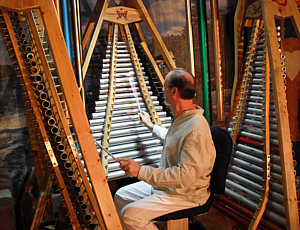 Coburn Tuller: Tuning was very involved. I had design a tuning device that consisted of a strobe tuner like what piano tuners use along with a frequency counter so I could know exactly each tone’s vibration. I would cut and listen, then trim by degrees until the note was right.
Coburn Tuller: Tuning was very involved. I had design a tuning device that consisted of a strobe tuner like what piano tuners use along with a frequency counter so I could know exactly each tone’s vibration. I would cut and listen, then trim by degrees until the note was right.
Shaving off too much, even the thickness of a sheet of paper, meant the Tone was too sharp and went to recycling. Even shooting a coat of clear finish on a Tone could make it sharp. My final method was to rough tune, finish, then fine tune and hope I didn’t go over. All in all, to get the 90 Tones I have now, I have been through more than 600 pieces of tubing.
The scale, too, is tricky because I wanted to tune to what is called Just Intonation, the scale that early classical music was played in and that is closest to the vibration of the major chakras. That way, the Tones would have a healing and relaxing effect. Since no other instrument is tuned to this scale, that was also a rather involved process.
John: I can see how involved the development has been. Now we have a better idea of the instrument you performed on for your first album entitled Butterfly Tones, could you tell us your early music history and educational background in music?
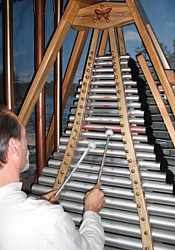 Coburn Tuller: I started playing guitar as a young teenager and especially liked open tunings. I built my first dulcimer at age 17 and even made a few for sale over the years. In 1978 I joined a Belly Dance Troupe called Arabesque. I was the leader of the band on a special two neck dulcimer/guitar instrument I fashioned from my Grandfather’s old Harp Guitar.
Coburn Tuller: I started playing guitar as a young teenager and especially liked open tunings. I built my first dulcimer at age 17 and even made a few for sale over the years. In 1978 I joined a Belly Dance Troupe called Arabesque. I was the leader of the band on a special two neck dulcimer/guitar instrument I fashioned from my Grandfather’s old Harp Guitar.
In college I took up piano and synthesizer as part of a music and dance major. In 1979 built a special 3 neck dulcimer I called the Dulcitar, following that in 1982 with a Yang Chin or Chinese Hammer Dulcimer, both of which I used to write the music for some of my dances and video pieces while at the university. I also wrote the songs and incidental music for a children’s production while there.
John: Knowing your earlier experiences as a musician, was it easy to make a transition and begin composing music for a completely new instrument, and how did you compose the music for your first album?
Coburn Tuller: Actually, I originally thought I would build and sell Tone Sets, but there was always one more improvement to make and when I had the present set completed, the music just started coming through. Fortunately, I had done recording before so it wasn’t a completely new and overwhelming proposition. It did take almost 3 years, however, to compose the 9 tracks on this CD. Sometimes it was merely waiting for inspiration but often I would get a new idea while fine tuning a particular note or I would hear a train whistle in the distance and hum a counterpoint which would begin a new piece. Sometimes I just hit the Tones and let them ring and played with melodies under the sustained notes. One day my sweetheart Mary said, “Just play the low and high C note,” so I did and that developed into Mystic Dream. I guess the short answer is various ways of composing.
 John: When you composed Butterfly Tones, did you write the musical notations for the 9 songs on a music sheet, or do you compose and perform by memory alone?
John: When you composed Butterfly Tones, did you write the musical notations for the 9 songs on a music sheet, or do you compose and perform by memory alone?
Coburn Tuller: I perform entirely by memory.
John: You and I had talked about the many possibilities in which your music can be applied to instrumental scores simply because of the unique intonations of your instrument. If the opportunity arose, would you consider collaborating with another musician by having other New Age artists utilize your music for a combined project together?
Coburn Tuller: Definitely. I would welcome collaboration and would love to be part of another project.
John: Given the fact there is a lot involved in composing, producing, and marketing an album, do you find being a recording artist who has marketed his first album a rewarding experience, and what are some of the challenges to marketing an album yourself?
Coburn Tuller: Fortunately, I published a book in 1995 so had some experience with marketing then. This introduced me to the major New Age distributors and magazines. The internet, however, has changed almost everything about the marketing game so it’s been rather a steep learning curve with much more to come. The biggest challenge is obtaining album reviews and seeing them published so that potential fans can learn about the music and be encouraged to listen to the clips online. I also have ads in the major magazines that go to buyers for the New Age Bookstores and boutiques. As always with doing anything yourself, it takes a lot of time but is rewarding when a project becomes successful like this one is becoming.
John: I read some great reviews on your website reviews page. Would you like to tell us what some of the other review publicists like me have said about The Tones and the innovative musical arrangements you have created on Butterfly Tones?
Coburn Tuller: The reception from major reviewers has been extraordinary! All in all, I couldn’t be more pleased with the excellent reception this CD is garnering.
Michael Diamond called the Tones “a stunning work of art” that “produces exquisite sounds that reverberate and sustain creating a sea of harmonic overtones.”
Kathy Parsons suggests the music as “an ideal accompaniment for massage, meditation and relaxation by taking a person’s focus into a new musical realm altogether.”
Bill Binkelman describes the music as “rich, resonant bell-like tones with amazing, sustained durations that overlap like ripples in a pond.”
Steven Ferrino said “I am noticing the ambiance of my office coming to life with the vibration of the notes filling the room. The playful notes seem to have a life of their own as they bounce off the wall.”
Alejandro Clavijo of ReviewsNewAge.com wrote my newest album review. Alejandro said; “Coburn Tuller has created a lovely album, unlike any other music CD on a percussion instrument. The instrument has a fascinating harmonic richness, depending on the intensity of the blow, the brightness and sound can vary in intensity and this creates a beauty that resides in each composition.”
John: I agree with them totally! The positive statements from these review publicists are a superb reflection of your work! Recently you told me you are planning on another project. Is your second release going to be similar to your first or do you have something else planned on your second recording?
Coburn Tuller: I have been talking with one musician friend in particular about putting some violin and/or mandolin tracks on my upcoming CD I plan to begin this fall.
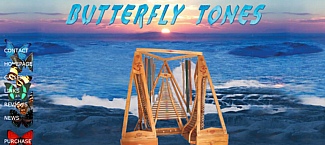 I think the next CD should have something new that expands on what has come before. As such, I have just completed the addition of a set of copper Tones to the main set which brings the count up to 120 Tones. The copper Tones have an almost Asian quality to them and a shorter sustain which allows for a different kind of melodic interplay.
I think the next CD should have something new that expands on what has come before. As such, I have just completed the addition of a set of copper Tones to the main set which brings the count up to 120 Tones. The copper Tones have an almost Asian quality to them and a shorter sustain which allows for a different kind of melodic interplay.
John: Sounds wonderful! We look forward to your second release. Coburn, I enjoyed meeting you, and hope we can arrange another get together soon. In closing, is there anything you would like to comment on that we haven’t talked about?
Coburn Tuller: Just to say I love the music The Tones can create and I am thrilled I can share it with your special audience.
Visit Coburn Tuller at his butterflytonescd.com homepage and visit his CDBaby.com or Amazon.com to sample or purchase. Read what others are saying on Coburn’s reviews page, and find more on our page dedicated to Coburn Tuller.
Photos are courtesy butterflytonescd.com.
Coburn Tuller from Springfield Missouri has released an innovative new album that has rapidly caught the attention of many review publicists recently. One reason for the upsurge of interest may be in direct relation to the unique melodic sounds heard on his first album, which are sounds produced from a musical instrument he invented named The Tones.
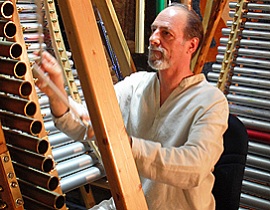 Coburn Tuller had first conceived the idea for his one of a kind instrument during a nighttime walk in 1996. After hearing wind chimes lightly touching in a gentle breeze he discovered the random series of sound sparked his creative imagination. Coburn then determined that aluminum tubing of accurate length, diameter and dimension produced an original sound modulation when struck with a mallet. Coburn then devoted the next 15 years perfecting his unique instrument.
Coburn Tuller had first conceived the idea for his one of a kind instrument during a nighttime walk in 1996. After hearing wind chimes lightly touching in a gentle breeze he discovered the random series of sound sparked his creative imagination. Coburn then determined that aluminum tubing of accurate length, diameter and dimension produced an original sound modulation when struck with a mallet. Coburn then devoted the next 15 years perfecting his unique instrument.
The Tones is a musical instrument that stands over 8 foot tall, and consists of 3 pyramid structures supporting 90 aluminum and brass tubes of various size and dimension, which range from 7 inches to over 6 foot in length. The sounds produced are like a new form of ambient music by the sound modulation which is totally unique, but one most likely considered a percussion instrument normally used in an orchestra like tubular bells. Regardless of how this instrument is classified the distinctive sounds, unlike drum beats, enable the creation of an independent melody.
Butterfly Tones is a relaxing album featuring 9 melodies which reveal this instrumental freedom of melodic expression. This natural resonating characteristic of bell tones becomes apparent on every piece, where multiple layers enhance a distinct harmony while Coburn ascends and descends through the scales using select octaves and tempos.
On the Butterfly Tones release you will notice every note produces a clear and precise harmony rather than a series of arbitrary sounds like you would hear on wood or metal wind chimes. The natural tone reverberation on his instrument is apparent on every octave of the bells which ring true, and create a tonal echo which can linger for minutes during a song. This is the most exclusive characteristics of the instrument with the only exception being the ingenuity of the inventor.
Visit the butterflytonescd.com homepage and read what others are saying on Coburn’s reviews page. To sample or purchase or visit his CDBaby.com page or Amazon.com page. Below is a song video of Once Again from his Butterfly Tones release. Read my review on our page dedicated to Coburn Tuller.
Rarely does an artist of any genre create an entirely new and unique sound identity they can claim entirely as their own. Butterfly Tones by Coburn Tuller, featuring 9 songs of melodic bell timbres is definitely one of the most exclusive musical arrangements I have ever heard. Coburn Tuller has not only created an innovative source of beautiful harmony for a broad multicultural audience, but his first contribution to the New Age music genre is by the same token, a new source of inspiration.
If one takes a minute to listen close enough, beautiful ambient music is all around us. It’s only natural those who live in the countryside have more time available to enjoy the serenity of a peaceful atmosphere verses those who live in an urban environment. Regardless of where you live, undesirable noise can strike any time of the day or night just like clockwork.
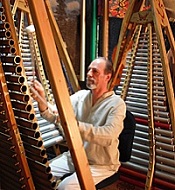 Coburn Tuller from the Springfield Missouri area, truly enjoys the best of both worlds. Not only does he live on the outskirts of a metropolitan area where annoying noise is at a minimum, but he also invented a musical instrument that produces peaceful and relaxing timbres any hour of the day or night he desires. The inherently unique musical creation he fabricated is named The Tones, and the relaxing qualities produced from this innovative instrument are the foundation for his first exclusive new release titled Butterfly Tones.
Coburn Tuller from the Springfield Missouri area, truly enjoys the best of both worlds. Not only does he live on the outskirts of a metropolitan area where annoying noise is at a minimum, but he also invented a musical instrument that produces peaceful and relaxing timbres any hour of the day or night he desires. The inherently unique musical creation he fabricated is named The Tones, and the relaxing qualities produced from this innovative instrument are the foundation for his first exclusive new release titled Butterfly Tones.
Coburn Tuller is first and foremost a talented musician, having reached a level of expertise on numerous instruments over the years including acoustic and electric guitar, dulcimer and piano. Coburn conceived the idea for his music innovation during walk around midnight back in 1996, when he heard wind chimes lightly touching in a gentle breeze.
While most of us are familiar with the sound of various wind chimes, and would think nothing further about this blend of manmade and natural ambience, the random series of sound fascinated him and sparked his imagination. Coburn then theorized this ambient sound could be taken to a whole new level, and determined that aluminum tubing of accurate length, diameter and dimension would produce an original sound modulation when struck with a mallet. He then accepted the challenge and spent the next 15 years perfecting his one of a kind instrument – The Tones.
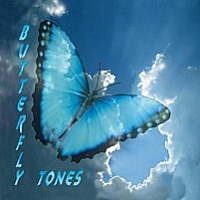 Butterfly Tones features 9 songs of melodic bell timbres that are without a doubt one of the more unique forms of music I have ever heard. The Tones itself is a musical instrument that stands over 8 foot tall, and consists of 3 pyramid structures supporting 90 aluminum and brass tubes of various size and dimension, which range from 7 inches to over 6 foot in length.
Butterfly Tones features 9 songs of melodic bell timbres that are without a doubt one of the more unique forms of music I have ever heard. The Tones itself is a musical instrument that stands over 8 foot tall, and consists of 3 pyramid structures supporting 90 aluminum and brass tubes of various size and dimension, which range from 7 inches to over 6 foot in length.
If one were to classify the musical invention, I would imagine it would most likely be categorized as a directly struck idiophone like tubular bells or a xylophone, both of which are percussion instruments most often used in an orchestra arrangement. But their distinctive sound also enables the creation of an independent melody.
The 9 songs on Butterfly Tones highlight this instrumental freedom of expression to create some beautiful pieces. During Coburn’s performance you will notice like I did that every note struck produces a clear and precise harmony rather than a series of arbitrary sounds. One of the most interesting effects is the natural tone reverberation in every octave of the bells which can linger for minutes during a song.
This natural resonating characteristic of bell tones is apparent on every piece, where multiple layers enhance a distinct harmony while Coburn ascends and descends through the scales using select octaves and tempos. I also noticed the array of notes struck in the bass range often transfer the background theme for each song in the treble range, but the delivery of treble notes likewise act as a counterbalance for bass notes during each arrangement. I would also say the vibrant resonating sound produced is either close to, or the equivalent of the same note intervals and harmonic pitch found on the diatonic scale. Regardless of which musical scale is used, the tones sound perfect in pitch on every octave and ring true.
Coburn Tuller has discovered a steadfast new source of peaceful ambience whose finely balanced sound qualities are available day, night, or anytime the bell tolls. If you listen for yourself I am sure you will agree this exclusive album presented on CD or MP3 has an elegant rhythm and symmetry for relaxation you can count on, just like clockwork.
Visit the butterflytonescd.com homepage and sample or purchase at Coburn’s CDBaby.com page or Amazon.com page.
Photos are courtesy butterflytonescd.com.



